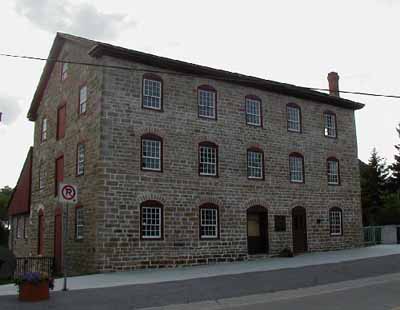Old Stone Mill National Historic Site of Canada
Delta, Ontario

General view
© Parks Canada Agency / Agence Parcs Canada, 2004.
Address :
near 44 Highway 42, Delta, Ontario
Recognition Statute:
Historic Sites and Monuments Act (R.S.C., 1985, c. H-4)
Designation Date:
1970-02-20
Dates:
-
1810 to 1810
(Construction)
-
1810 to 1949
(Significant)
Event, Person, Organization:
Other Name(s):
-
Old Stone Mill
(Designation Name)
Plaque(s)
Existing plaque: Front wall of building. near 44 Highway 42, Delta, Ontario
The first mill on this site was built about 1796 by Abel Stevens, a loyalist and early industrialist from Vermont. After 1800 the property passed to a member of a prominent local family, William Jones, who by 1810 had constructed the present stone mill. One of the oldest surviving mills in Ontario, it is a fine example of early Canadian architecture and a reminder of the pioneer industrial development of eastern Ontario.
Description of Historic Place
The Old Stone Mill National Historic Site of Canada is a three-storey high stone, grist mill comprised of an 1810 mill and an attached turbine shed, built in the 1860s. The Old Stone Mill is a water mill located on Delta Creek in the small village of Delta, nestled between Upper and Lower Beverly lakes, in the Rideau Lakes area north of Kingston. The formal recognition refers to the mill structure including the turbine shed.
Heritage Value
The Old Stone Mill was designated a national historic site of Canada in 1970 because: it is one of the oldest surviving mills in Ontario; it is a fine example of early Canadian architecture; it is a reminder of the pioneer industrial development of eastern Ontario.
Built in 1810 by William Jones, the Old Stone Mill in Delta is the earliest surviving stone mill in Ontario. The mill features high-quality stonework and was technologically advanced for its time. The building’s height, scale, and roof truss configuration were designed to accommodate the Oliver Evans automatic milling system, a late-18th-century innovation that improved the movement of grain through mill buildings.
Typical of early-19th-century mills in eastern Ontario, the Old Stone Mill played an important role in the settlement and economic development of Leeds County. The existence of the mill encouraged agricultural settlement in the area and led to the development of the village of Delta. The mill was in continuous use from 1810 to 1949. The replacement of the original waterwheel with cast-iron turbines in 1860 (housed in a new turbine shed), and the instalment of roller-milling machinery in 1893, showed the mill’s attempts to remain commercially viable in the late-19th century.
Sources: Historic Sites and Monuments Board of Canada, Minutes, February 1970; Commemorative Integrity Statement, January 1999.
Character-Defining Elements
Key elements contributing to the heritage value of this historic site include: its location; its three-storey, rectangular massing its composition of five-bay façades with three-bay end elevations; the industrial design elements related to the automatic milling process, including the three-storey height of the building, the raceway, window arches, and the scale and configuration of the floor; the surviving original structural and ornamental details, interior fittings, and finishes; the elements of its layout which relate to the early industrial use of the building, including its open spaces, and circulation patterns; its masonry construction with exterior walls of uneven coursed local stone with heavy stone corner quoins; its neo-classical, exterior detailing, including its bays trimmed with graceful, segmentally arched, stone voussoirs, and the return eaves at gable ends; its roof truss system; its virtually intact upper floor; the remaining mill workings and machinery including the 1869 turbine drive system; any archaeological remains, including the basement, raceways and areas adjacent to the foundation of the structure relating to the early 19th-century occupation and operation of the mill; any vestiges of and signs of wear from 19th-century milling machinery.